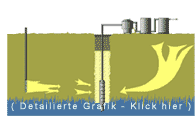



Possible Areas of Application
The IEG-double-cased-screen when implemented in a vapor extraction well improves the flow conditions around the well and can also be used to treat the often highly contaminated capillary fringe.
System Components
The double-cased screen con-sists of fine-grained hydrophobic filter granu-les sand-wiched between two layers of metal sieve web having an open screen area of over 50%. The metal web is con-structed such that an artificial pack cannot considerably reduce the open screen area. Air/water phase separa-tion takes place in the DMF in order to avoid moisture take-up of the extracted air. The special design of the DMF also leads to a constant and laminar flow of the extracted soil gas.
Description of Method
Soil air venting is conventionally carried out using small-sized boreholes which extend to just under the groundwater table and are outfitted with screens of diameters up to 50 mm. Depending on the size of the equipment and the properties of the soil, blowers are usually operated at pressure differences of 40 to 120 inches of water. The high negati-ve pressure draws perched or capillary water into the venting system. Conventional venting systems also generate turbulences in the vicinity of the screen segment which leads to a reduc-tion in venti-la-tion capacity and to excessive heating of the blower and the off-gas used to operate the system.
The IEG-double-cased-screen can be used with much lower negati-ve pressures. By accurately posi-tioning the DMF it is possi-ble to attain the necessary air-lift velocity to remove dense soil air charged with contami-nants from the bottom of the well. Since contaminant concentrations often reach a maximum within the capillary zone, the double-cased screen is normally placed within this area. Due to laminar flow generated when ex-trac-ting soil air via a DMF, this venting process can also be applied in less perme-able soil using negative pres-sures between 1 and 12 inches of water within the screen segment.
The following advantages of the IEG-double-cased-screen (DMF) can be specified
- Open screen area of about 50%
- Due to application of stainless steel and hydrophobic (or oleophilic) materials screens are resistant to chemical or physical affects
- No sorption of contaminants
- Soil vapor extraction is possible in less permeable soils
- Increase in the percentage removal of the pollutants from the -subsoil
- Inclusion of the capillary zone in the remediation process
- System needs less energy and less maintenance
- maximal utilization of the adsorptive capacity of the activated carbon filter
- Larger effective radius than with conventional vapor extraction systems
- Lower number of ventilation wells required for the remediation of a specific area
- Reduction in the total remediation time due to accurate extraction and/or venting of the subsurface
Soil Vapor Extraction with IEG-double-cased-screens and vapor extraction together with active or passive reinjection wells or vent points are processes patented by IEG Industrie Engineering GmbH, D-72770 Reutlingen, Germany.